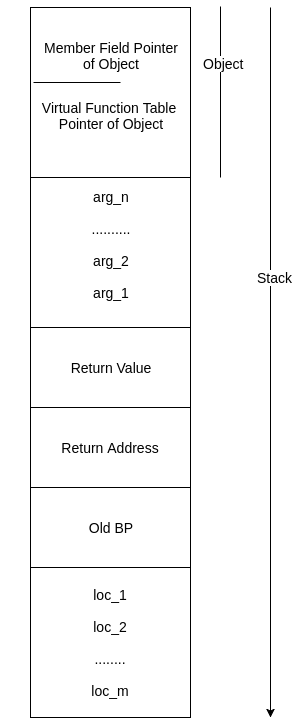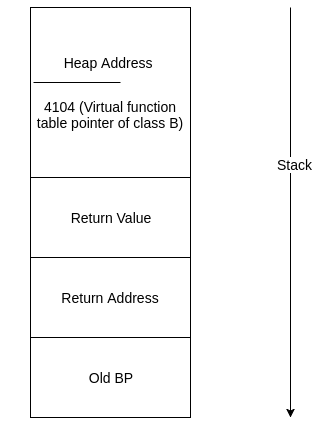OEXPL Run Time Binding Tutorial¶
Consider the OExpL code given below extending the classes here
decl
A obj ;
enddecl
int main() {
decl
int temp,n;
enddecl
begin
temp= initialize();
read(n);
if(n < 0)then
obj = new(A);
else
if(n == 0)then
obj = new(B);
else
if(n > 0)then
obj = new(C);
endif;
endif;
endif;
write(obj.f0()); /* Have a careful look at this call */
return 1;
end
}
In the above code, the value of n is read from the console and not known at the compile time.
Consider the call write(obj.f0()); in the above code.
if (n < 0), the method f0() of the class A is invoked at run time. If (n = 0), the method f0() in the class B is invoked at run time and If (n > 0), the method f0() in the class C is invoked at run time. So, Depending on the value of n, the variable obj must be bound to a different class. Note that the value of n is known only when the program is run (at run time) and not known statically determined (i.e., not known at compile time). Even though the three methods which are overridden has the same name f0(), the call addresses must be different in each case. The information in the virtual function tables will be useful here.
We noted earlier that the variable obj has two words of memory assigned to it at compile time - one member field pointer and one virtual function table pointer. At run time, the member field pointer of obj is used to store a pointer to the space allocated in the heap as done for user defined type variables. The virtual function table pointer is used to store the start address of the virtual function table of the class assigned to obj at run time.
For instance, the statement obj = new(A); must result in two actions:
- The member field pointer of obj must be set to a newly allocated heap block.
- The virtual function table pointer of obj must be set to the start address of the virtual function table of class A.
Similarly, obj = new(B); must result in setting the virtual function table pointer of obj to the base address of the virtual function table of class B. Consequently, the compiler can resolve the call obj.f0(); by generating code to:
- Use the virtual function table pointer field of obj to find the address of the virtual function table of the class.
- Look up the virtual function table to find the address (label) of the function f0().
- Call the function (of course, after setting up the call stack).
In more detail, when the compiler encounters the statement obj=new(B); code is generated for the following:
- Call the library routine for Alloc to allocate heap memory. The address returned is stored into the member field pointer of obj.
- Set the virtual function table pointer of obj to the base address of the virtual function table of the class B (i.e, 4104).
Note that before generating code, compile time check whether B is a descendant class of the class of obj (in this case A) must be made.
For the call obj.f0(), the compiler must do the following:
- Find the index of f0() in the class table entry of obj. Here obj is declared to be of class A and the index (look up Funcposition field in the member function list of class A) of f0() in class A will be 0.
- Generate the code to move to a register (say R0) the label of the function at index 0 from the virtual function table of obj. The virtual function table pointer field of obj will point to the virtual function table.
- Generate code to push the "self object" into the stack as argument (i.e., the member field pointer of obj and the virtual function table pointer of obj must be pushed as arguments to the call to f0() - See function call convention for methods below .)
- Generate code to call the function using the label obtained in step 2. (call R0).
- Generate code to unwind the stack and extract return values upon return from the call. Note that compile time check whether f0() is a method in the class A to which obj is declared to must be done before proceeding to code generation.
Run time Stack Management for Method invocations¶
While generating the code for invoking a method of a class using an object of the class (for example, in the call obj.f0() above, f0() is invoked using the object obj of class A) the member field pointer and virtual function table pointer of the object must be pushed to the stack in addition to normal arguments of the function. We will follow the convention that these two values will be pushed before other arguments are pushed. This is how the runtime stack looks, when a method of a class is called.

For instance, in the above example, if the value read from the input is 0, the following figure shows the run time stack.

Need For Pushing The Object¶
According to OExpL Specification, a member field or method should be accessed using self. In order to find out which object we are talking about,when we say self, we need to push the object into the stack.
Consider the following OExpL program,
class
A
{
decl
int i;
int f0();
int f1();
enddecl
int f0() {
decl
int c;
enddecl
begin
c = self.f1(); // call to f1() from f0()
write(self.i);
return 1;
end
}
int f1() {
decl
enddecl
begin
self.i=0;
write("In A F1"); // This is printed when f1() is invoked from an object of class A
return 1;
end
}
}
B extends A
{
decl
int f1(); // B overrides f1
enddecl
int f1() {
decl
enddecl
begin
self.i=1;
write("In B F1"); // This is printed when f1() is invoked from an object of class B
return 1;
end
}
}
endclass
decl
int n;
A obj;
enddecl
int main() {
decl
enddecl
begin
read(n);
if(n>0) then
obj = new(A);
else
obj = new(B);
endif;
n = obj.f0(); // f0() contains a call to f1(). f1() is overriden by class B
return 1;
end
}
For obj1, the member field height must be set to 10. For obj2, the member field height must be set to 20.
In the method definition for the method setHeight, the member field height is set by using the statement, self.height = a;. By this statement alone, we cannot say which object is self referring to. To identify which object is self referring to, we push the calling object to the stack.
If obj1 calls the method setHeight, the member field pointer and virtual function table pointer of obj1 are pushed into the stack. Now, we know that obj1 is calling the method (By looking at the runtime stack). So, we set the member field height of obj1 by using the member field pointer and the field position of member field height. Member field pointer is the heap address given to the object for storing the member fields of the class it is assigned with.
The virtual function table pointer is used, when we invoke other methods using self. p = self.setHeight(5); //In the method defaultHeight(). For this we need to generate a CALL instruction. The call address is obtained from virtual function table.